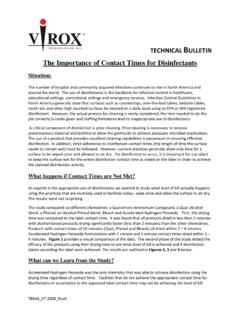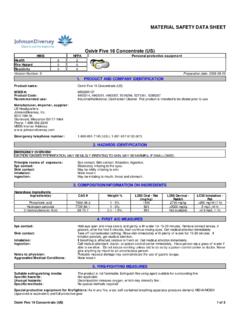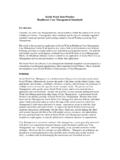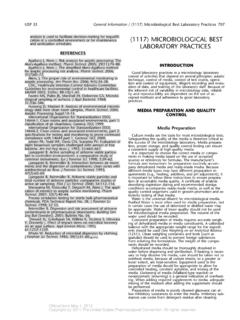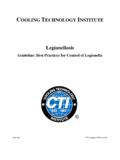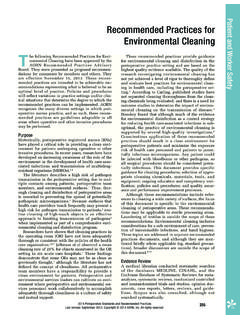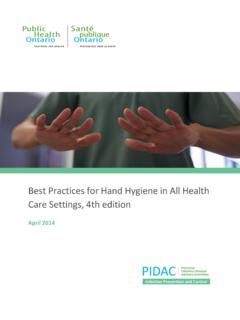Transcription of Best Practices for Infection Prevention and (PIDAC ...
1 BBeessttPPrraaccttiicceessffoorrIInnffee ccttiioonnPPrreevveennttiioonnaannddCCoo nnttrroollPPrrooggrraammssiinnOOnnttaarr iiooIProvincial Infectious Diseases Advisory Committee (PIDAC )InnAAllllHHeeaalltthhCCa arreeSSeettttiinnggssMinistry of health and Long-Term care Published September 2008 best Practices for Infection Prevention and Control Programs in Ontario September 2008 Disclaimer for best Practice Documents This document was developed by the Provincial Infectious Diseases Advisory Committee (PIDAC). PIDAC is a multidisciplinary scientific advisory body who provide to the Chief Medical Officer of health evidence-based advice regarding multiple aspects of infectious disease identification, Prevention and control.
2 PIDAC s work is guided by the best available evidence and updated as required. best Practice documents and tools produced by PIDAC reflect consensus positions on what the committee deems prudent practice and are made available as a resource to the public health and health care providers. All or part of this report may be reproduced for educational purposes only without permission, with the following acknowledgement to indicate the source: Ontario Ministry of health and Long-Term care /Public health Division/Provincial Infectious Diseases Advisory Committee Toronto, Canada September 2008 ISBN # 978-1-4249-4832-1 [English version] ISBN # 978-1-4249-4833-8 [French version] Page 2 of 88 pages best Practices for Infection Prevention and Control Programs in Ontario September 2008 PIDAC would like to acknowledge the contribution and expertise of the subcommittee that developed this document: Infection Prevention and Control Subcommittee Dr.
3 Mary Vearncombe, Chair Medical Director, Infection Prevention and Control, Microbiology Sunnybrook health Sciences Centre and Women s College Hospital Mary Lou CardManager, Infection Prevention and Control London health Sciences Centre and St. Joseph s health care Dr. Maureen Cividino Occupational health Physician St. Joseph's Healthcare, Hamilton Renee Freeman Infection Control Practitioner Hospital for Sick Children, Toronto Dr. Michael GardamDirector, Infection Control University health Network, Toronto Dr. Beth Henning Medical Officer of health Huron County Dr. Allison McGeer Director, Infection Control Mount Sinai Hospital, Toronto Pat Piaskowski Network Coordinator Northwestern Ontario Infection Control Network Dr.
4 Virginia Roth Director, Infection Prevention and Control Program The Ottawa Hospital Dr. Dick Zoutman Professor and Chair, Divisions of Medical Microbiology and of Infectious Diseases Medical Director of Infection Control, South Eastern Ontario health Sciences Centre Queen s University, Kingston, Ontario Co-Chair, Provincial Infectious Diseases Advisory Committee (PIDAC) Dr. Erika Bontovics (ex-officio member) Senior Infection Prevention and Control Consultant Public health Division, Ministry of health and Long-Term CareClare Barry (ex-officio member) Senior Infection Prevention and Control Consultant Strategic Planning & Implementation Branch, Public health Division, Ministry of health and Long-Term care Liz Van Horne (ex-officio member)
5 Infection Prevention and Control Consultant Strategic Planning & Implementation Branch, Public health Division, Ministry of health and Long-Term CarePIDAC would also like to acknowledge the writing of this best Practices guide provided by Shirley 3 of 88 pages best Practices for Infection Prevention and Control Programs in Ontario September 2008 Table of Contents EXECUTIVE 7 About This 8 Evidence for and When to Use This 8 Abbreviations .. 10 Glossary of 151. What are health care -Associated infections ? .. 152.
6 Adverse health care Events and health care -Associated infections .. 153. The Cost of health care -Associated infections .. 16II. THE Infection Prevention AND CONTROL (IPAC) PROGRAM .. 17 Patient Safety and Infection Prevention and 17 Impact of IPAC Programs .. 171. Mandate/Goals and Functions of the IPAC Program .. 182. Structure and Elements of the IPAC Program .. 19 Structure of the IPAC Program ..19 Elements of the IPAC Program ..193. The Infection Prevention and Control Committee (IPACC).. 204. IPAC Program 22 Outcome 22 Indicators .. 24 Policies and with Legislation and Accreditation Standards.
7 29 health care Regulations Pertaining to Infection Prevention and Control .. 30 Occupational health and Safety Issues ..31 Education, Training and Evaluation of Infection Prevention and Control Programs ..34 Education and Training in Infection Prevention and Control .. 34 Evaluation of Infection Prevention and Control Education 36 Other Key Components of the IPAC Program ..36 Hand Hygiene .. 36 Routine Practices and Additional 40 Cluster/Outbreak Management and Investigation .. 41 Communications .. 43 III. RESOURCES FOR THE IPAC PROGRAM .. 451. Human 45 The Infection Prevention and Control Professional (ICP).
8 45 Education, Training and Certification of 46 Ongoing Professional Competency of ICPs .. 46 Roles and Responsibilities of 47 Page 4 of 88 pages best Practices for Infection Prevention and Control Programs in Ontario September 2008 ICP Staffing Levels .. 48 The Infection Prevention and Control Physician ..49 Administrative Assistant ..50 Other Human Other Program Resources .. 51 Laboratory Administrative Support .. 52IV. SUMMARY OF 53 Appendices Appendix A: Resources for Infection Prevention and Control .. 66 Appendix B: APIC/CHICA-Canada/CBIC Infection Control and Epidemiology: Professional and Practice 74 References.
9 80 Page 5 of 88 pages best Practices for Infection Prevention and Control Programs in Ontario September 2008 Executive Summary health care -associated infections (HAIs) are defined as infections that occur as a result of health care interventions in any health care setting where care is delivered. health care -associated infections remain an important patient safety issue and represent a significant adverse outcome of the health care system. The acquisition of occupationally-acquired infections may pose a risk to health care providers.
10 In both acute and long-term care , outbreaks result in significant cost to the organization. In order to protect clients/patients/residents and staff and to reduce the costs of health care -associated infections , it is necessary to prevent infections before they occur. Recent studies suggest that at least 20% of HAIs could be prevented through Infection Prevention and control strategies. Infection Prevention and control (IPAC) programs have been shown to be both clinically effective and cost-effective, providing important cost savings in terms of fewer health care -associated infections , reduced length of hospital stay, less antibiotic resistance and decreased costs of treatment for responsibility for the Infection Prevention and control program in the health care setting lies primarily with the senior administration of the organization.

